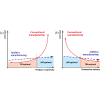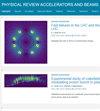Metal additive manufacturing for particle accelerator applications
IF 1.5
3区 物理与天体物理
Q3 PHYSICS, NUCLEAR
Physical Review Accelerators and Beams
Pub Date : 2024-05-17
DOI:10.1103/physrevaccelbeams.27.054801
引用次数: 0
Abstract
Metal additive manufacturing technologies are rapidly becoming an integral part of the advanced technological portfolio for the most demanding industrial applications. These processes are capable of fabricating three-dimensional components with near-net shape quality by depositing the constituent materials in a layer-by-layer fashion. This fabrication approach provides numerous advantages over conventional manufacturing methods, including enhanced design flexibility, reduced production costs and lead times, rapid prototyping, and the possibility to repair damaged parts. In recent years, the growing demand for novel accelerator components with improved performance characteristics, integrating structures such as drift tubes and internal cooling channels, has prompted the exploration of additive manufacturing in the field of particle accelerators. Radio-frequency components, beam intercepting devices, and vacuum systems have been prototyped using various metallic materials and additive manufacturing technologies, demonstrating performance levels comparable to the conventionally manufactured counterparts in preliminary tests. However, the absence of established qualification protocols and the uncertain reliability of additively manufactured parts under the demanding conditions typical of accelerator applications pose significant challenges to the integration of additive manufacturing processes into the fabrication practices of these components. This paper provides a comprehensive review of documented applications of metal additive manufacturing in particle accelerators, highlighting benefits, challenges, and opportunities for future improvements. The main requirements and currently available test setups for the assessment of additively manufactured components in applications involving ultrahigh vacuum and intense electromagnetic fields are also discussed.

用于粒子加速器的金属快速成型技术
金属增材制造技术正迅速成为最苛刻工业应用领域先进技术组合的组成部分。这些工艺通过逐层沉积组成材料,能够制造出接近净形质量的三维部件。与传统制造方法相比,这种制造方法具有众多优势,包括提高设计灵活性、降低生产成本和缩短交货时间、快速制作原型以及修复损坏部件的可能性。近年来,对具有更佳性能特点的新型加速器组件(集成漂移管和内部冷却通道等结构)的需求不断增长,这促使人们在粒子加速器领域探索快速成型制造技术。射频组件、光束拦截装置和真空系统已利用各种金属材料和增材制造技术制成原型,在初步测试中显示出与传统制造的同类产品相当的性能水平。然而,在加速器应用的典型苛刻条件下,增材制造部件缺乏既定的鉴定协议,可靠性也不确定,这给将增材制造工艺集成到这些部件的制造实践中带来了巨大挑战。本文全面回顾了金属快速成型制造在粒子加速器中的有据可查的应用,重点介绍了其优点、挑战和未来改进的机会。本文还讨论了在涉及超高真空和强电磁场的应用中评估增材制造部件的主要要求和当前可用的测试装置。
本文章由计算机程序翻译,如有差异,请以英文原文为准。
求助全文
约1分钟内获得全文
求助全文
来源期刊

Physical Review Accelerators and Beams
Physics and Astronomy-Surfaces and Interfaces
CiteScore
3.90
自引率
23.50%
发文量
158
审稿时长
23 weeks
期刊介绍:
Physical Review Special Topics - Accelerators and Beams (PRST-AB) is a peer-reviewed, purely electronic journal, distributed without charge to readers and funded by sponsors from national and international laboratories and other partners. The articles are published by the American Physical Society under the terms of the Creative Commons Attribution 3.0 License.
It covers the full range of accelerator science and technology; subsystem and component technologies; beam dynamics; accelerator applications; and design, operation, and improvement of accelerators used in science and industry. This includes accelerators for high-energy and nuclear physics, synchrotron-radiation production, spallation neutron sources, medical therapy, and intense-beam applications.
 求助内容:
求助内容: 应助结果提醒方式:
应助结果提醒方式:


